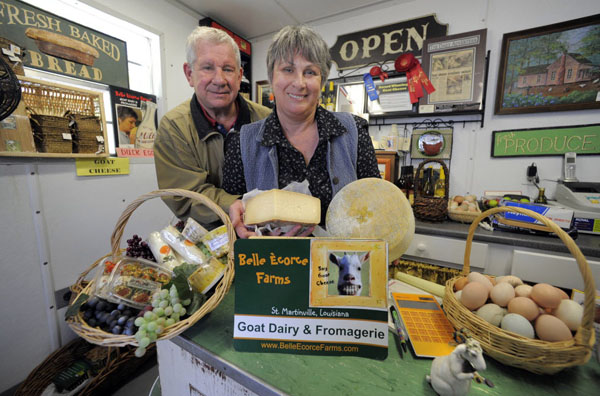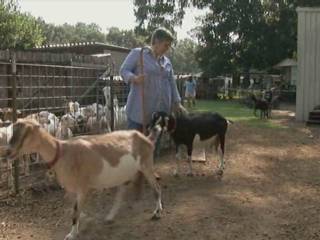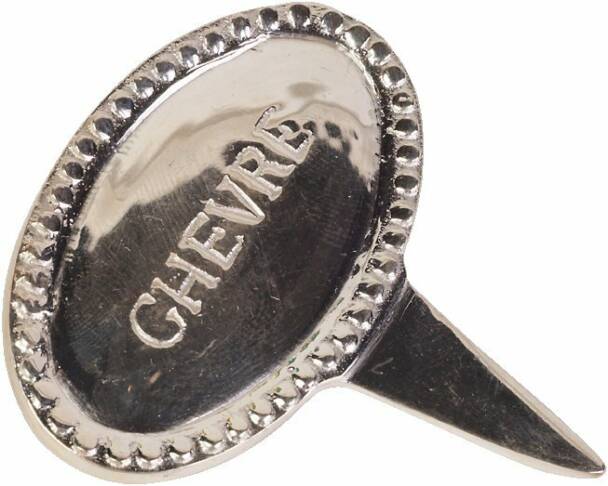
Très Belle Chèvre
Goat Dairy & Fromagerie

Featured in The Advocate Newspaper---March 24, 2011
ARTICLE---Got Her Goat
Goats Lead to Cheese Business
By CHERAMIE SONNIER, Assistant Food Editor
MADE IN LOUISIANA
Advocate staff photos by TRAVIS SPRADLING
In the small store at Belle Ècorce Farms in St. Martinville, owners Kenny Barras and his wife, Wanda Barras, show off some of the cheeses made at the goatdairy and fromagerie. Chicken and duck eggs also are available at their store.
ST. MARTINVILLE — When, on a whim, Wanda Barras acquired two female goats, she didn’t plan on going into the artisan/farmstead goat cheese business.
But, 12 years later, she is making awardwinning goat cheeses at her family’s farm on the banks of Bayou Teche. Those two registered, no-eared Lamancha dairy goats produced babies a couple of months after she got them in 1999, and Barras found herself milking goats by hand on her home’s front porch. Now, “we have 40 milkers — the maximum our facility can handle — which give about 20 gallons a day. We’re a
micro dairy … , ” Barras said during a tour of her state-licensed goat dairy and cheese facility March 10. “And, we have 50 plus babies and more on the way.” Barras and her husband, Kenny Barras, are the owners of Belle Ècorce Farms, a limited liability corporation which operates Très Belle Chèvre, the goat dairy and fromagerie; Cage’N Bird, an exotic parrot breeding facility and avian hand-feeding and breeder supply mail order company; and Bar U5 Miniature Horses Farm. Wanda Barras
also has plans to breed her pet hairless Sphynx cats. Barras’ love of animals is well known to their neighbors, Kenny Barras said. “I guarantee you, if there are some animals someone doesn’t want, they bring
them to Wanda …” “And, I take them,” she added. Today, their farm on South Main Street in St. Martinville is hometo at least 100 exotic birds, includingAmazons, African
Grays, Cockatoos and Macaws;eight miniature horses; “Honey,”a very friendly, 1-year-old Jersey heifer which belongs tothe Barras’ grandson, Tré Theriot, 13; several dogs, including “Scottie,” a black-and-white terrier who lives with the goats and breaks up fights; plus an assortment of exotic-looking geese, ducks and chickens.
But, it is Barras’ goats and the handmade chèvre
cheeses which draw the most attention. Some of
her cheeses have been national award-winners in
competitions hosted by United States Cheese
[Competition], American Cheese Society and
American Dairy Goat Association.
Milk and cheese production is seasonal at Belle
Ècorce Farms. “The traditional goat milk season
in Europe is Easter to All Saints Day — about March
to late October — and we follow those traditions,” Wanda Barras said. Selected does are bred each fall to ensure they have babies in the spring. “Goats can have one to four babies. Two or three is normal, and they must breed to produce milk,” she explained.
The goats are milked twice a day, six at a time. The milk is then filtered (strained), pasteurized and cooled. Bacterial cultures and rennet, a substance used to curdle milk, is added to encourage curd formation. The milk rests until the curds are formed. When curds reach about the consistency of yogurt, they are put in cheesecloth bags to drain overnight over a large sink or they are ladled into molds. The procedures
depends on the type of cheese being made.
Some will become chèvre, a cream cheese that is put into containers when soft or made into logs when stiffened. For Belle Ècorce’s feta-style cheese, made in 10-gallon batches, curds are ladled into a mold, drained and dried for two days, then cut into 1-inch cubes and hand salted. Barras occasionally makes a soft, fresh ricotta cheese.
The mold-ripened, or bloomyrind, chèvre must go from curds to special containers to drain, she said. “They are turned over once or twice a day for one or two days. They are taken out of the molds, hand salted and dried on the counter, then cured and aged at 50 to 55 degrees,” Barras said. She knows when they are ready by their look. “There’s a certain texture I’m looking for, a certain feel, not too sticky and not too dry. Everything affects it — the environment, who makes it.”
A few relatives and part-time employees help with operations at the goat and cheese facility. Among them are Nicole Arceneaux, a cousin who does everything from schedule goat husbandry workshops to milking; Mandy Hebert, who helps with cheese production, and Josie Foti, who decorates the cheeses with Belle Ècorce’s signature
seasonings and fresh herbs grown on the farm.
“Only thing I do is help on Saturdays at the Red Stick Farmers’ Market,” held from 8 a.m. to noon in downtown Baton Rouge, said Kenny Barras, a [oil field and comercial] contractor who owns Modular Construction, located near the family home.
“Kenny also built all this for me,” Wanda Barras said, making a sweeping motion with her arms to take in the farm store, the production facility and the new cheese cave, where she ages French-inspired soft, bloomy-rind, mold-ripened cheeses; raw milk hard cheeses; and other specialty cheeses.
Barras, who speaks rapidly and enthusiastically as she talks about cheese making, said, “We make nine different kinds of semi-soft cheeses, including two
raw milk cheeses. … To sell raw milk cheese legally in Louisiana, it must be aged over
60 days so the acidity will kill off any harmful bacteria.”
Goat’s milk cheeses sometimes get a bad rap because they are perceived as having an off flavor, Barras writes on the company’s website, http://belleecorcefarms.com.
But, she says, that’s only true if the milk was mishandled. “Fresh goat milk is delicate and mild, with a subtle aromatic background. … A good goat cheese will be herbaceous and taste of the fresh grasses, herbs and flowers that the goats graze
on.
Belle Ècorce cheeses are available in its farm store; through the website http://tresbellechevrecheese.homestead.com; most Saturday mornings at the Red StickFarmers Market, located on Fifth Street between North and Main streets in downtown Baton Rouge; at Champagne's Market and Joey’s Specialty Foods in Lafayette; and St. James Cheese Co. in New Orleans. It is also found on some restaurants’ menus, including those of NOLA and [John Bech's] Restaurant August, both in New Orleans; in Lafayette Jolie's Louisiana Bistro, Cena's and Village Cafe in River Ranch; Catahoula's in Grand Coteau; and Bella Fegura in Shreveport.
For more information about Belle Ècorce Farms and its cheeses or to schedule tours,
call (337) 394-6683 or email wbarras@aol.com.



